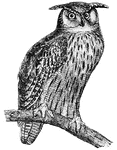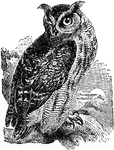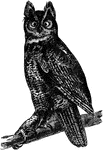Clipart tagged: ‘great horned owl’

Great Horned Owl
Horned owls are distinguished by two tufts or horns of feathers placed on each side of their head.

Great Horned Owl
The American horned owls and the Old World eagle-owls make up the genus Bubo, at least as traditionally…

Great Horned Owl
"Bubo virginianus. Great Horned Owl. Hoot Owl. Cat Owl. Distinguished by its large size and conspicuous…